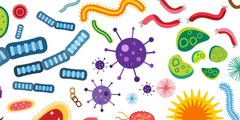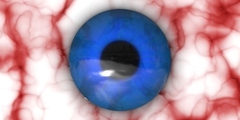
Koolstofmonoxide (CO) is een kleur-en reukloos gas. Het is
niet-irriterend en ontstaat van nature bij de onvolledige
verbranding van koolwaterstoffen. Na inademing gaat CO de strijd
aan met zuurstof (O2). Het gevolg daarvan is dat CO
wordt beschouwd als een toxisch gas. Maar mogelijk zijn er
therapeutische effecten aan verbonden.
Beste bezoeker, u heeft geen toegang.
Enkel (web)abonnees hebben toegang tot tijdschriftartikelen. Het webabonnement is nog in de maak.
U kunt zich wel alvast (gratis) registreren en tal van andere webartikelen raadplegen!
Auteur
Trefwoorden:
Verschenen in
Referenties
Foresti, R., Bani-Hani, M. G., & Motterlini, R. (2008). Use of carbon monoxide as a therapeutic agent: promises and challenges. Intensive Care Med 34, 649−658. Sjostrand, T. (1970). Early studies of CO production. Ann NY Acad Sci 174, 5−10.
Rodgers, P. A., Vreman, H. J., Dennery, P. A., & Stevenson, D. K. (1994). Sources of carbon monoxide (CO) in biological systems and applications of CO detection technologies. Semin Perinatol 18, 2−10.
Verma, A., Hirsch, D. J., Glatt, C. E., Ronnett, G. V., & Snyder, S. H. (1993). Carbon monoxide: a putative neural messanger. Science 259, 381−384.
Yachie, A., Niida, Y., Wada, T., Igarashi, N., Kaneda, H., Toma, T., et al. (1999). Oxidative stress causes enhanced endothelial cell injury inhuman hemeoxygenase-1deficiency. J Clin Invest 103, 129−135.
Poss, K. D., & Tonegawa, S. (1997). Reduced stress defense in haemoxygenase 1-deficient cells. Proc Natl Acad Sci USA 94, 10925−10930.
Otterbein, L. E., Zuckerbraun, B., Haga, M., Liu, F., Song, R., Usheva, A., et al. (2003a). Carbon monoxide suppresses arteriosclerotic lesions associated with chronic graft rejection and with balloon injury. Nat Med 9, 183−190.
Otterbein, L. E., Otterbein, S., Ifedigbo, E., Liu, F., Morse, D., Fearns, C., et al. (2003b). MKK3 mitogen-activated protein kinase pathway mediates carbon monoxideinduced protection against oxidant-induced lung injury. Am J Pathol 163, 2555−2563.
Song, R., Kubo, M., Morse, D., Zhou, Z., Zhang, X., Dauber, J. H., et al. (2003). Carbon monoxide induces cytoprotection in rat orthotopic lung transplantation via antiinflammatory and anti-apoptotic effects. Am J Pathol 163, 231−242.
Zuckerbraun, B., Billiar, T., Otterbein, S., Kim, P., Liu, F., Choi, A., et al. (2003). Carbon monoxide protects against liver failure through nitric oxide-induced heme oxygenase 1. J Exp Med 198, 1707−1716
Zuckerbraun, S., Chin, B., Wegiel, B., Billiar, T., Csizmadia, E., Rao, J., et al. (2006). Carbon monoxide reverses established pulmonary hypertension. J Exp Med 203, 2109−2119.
Kourembanas, S. (2002). Hypoxia and carbon monoxide in the vasculature. Antioxid Redox Signal 4, 291−299.
Brouard, S., Berberat, P., Tobiasch, E., Seldon, M., Bach, F., & Soares, M. (2002). Heme oxygenase-1-derived carbonmonoxide requires the activation of transcription factor NF-kappa B to protect endothelial cells from tumor necrosis factor-alpha-mediated apoptosis. J Biol Chem277, 17950−17961.
Wagener, F., Volk, H., Willis, D., Abraham, N., Soares, M., Adema, G., et al. (2003). Different faces of the heme–heme oxygenase system in inflammation. Pharmacol Rev 55, 551−571.
Sato, K., Balla, J., Otterbein, L., Smith, R., Brousar, S., Lin, Y., et al. (2001). Carbonmonoxide generated by heme oxygenase-1 suppresses the rejection of mouse-to-rat cardiac transplants. J Immunol 166, 4185−4194.
Motterlini, R., Mann, B. E., Johnson, T., Clark, J., Foresti, R., & Green, C. (2003). Bioactivity and pharmacological actions of carbon monoxide-releasing molecules. Curr Pharm Des 9, 2525−2539.
Taille, C., El-Benna, J., Lanone, S., Boczkowski, J., & Motterlini, R. (2005). Mitochondrial respiratory chain and NAD(P)H oxidase are targets for the antiproliferative effect of carbon monoxide in human airway smooth muscle. J Biol Chem 280, 25350−25360.
Ryter SW, Alam J, Choi AM. Heme oxygenase-1/carbon monoxide: from basic science to therapeutic applications. Physiol Rev 2006;86:583-650.
Motterlini R, Otterbein LE. The therapeutic potential of carbon monoxide. Nat Rev Drug Discov 2010;9:728- 743.
Otterbein LE, Bach FH, Alam J, et al. Carbon monoxide has anti-inf lammatory effects involving the mitogen-activated protein kinase pathway. Nat Med 2000;6:422- 428.
Brouard S, Otterbein LE, Anrather J, et al. Carbon monoxide generated by heme oxygenase 1 suppresses endothelial cell apoptosis. J Exp Med 2000;192:1015-1026.
Kim HP, Ryter SW, Choi AM. CO as a cellular signaling molecule. Annu Rev Pharmacol Toxicol 2006;46:411-449.
Durante W, Johnson FK, Johnson RA. Role of carbon monoxide in cardiovascular function. J Cell Mol Med 2006;10:672-686.
Suematsu M, Kashiwagi S, Sano T, Goda N, Shinoda Y, Ishimura Y. Carbon monoxide as an endogenous modulator of hepaticvascular perfusion. Biochem Biophys Res Commun 1994;205:1333-1337.
Morita T, Mitsialis SA, Koike H, Liu Y, Kourembanas S. Carbon monoxide controls the proliferation of hypoxic vascular smooth muscle cells. J Biol Chem 1997;272:32804-32809.
Otterbein LE, Otterbein SL, Ifedigbo E, et al. MKK3 mitogen-activated protein kinase pathway mediates carbon monoxide induced protection against oxidant-induced lung injury. Am J Pathol 2003;163:2555-2563.
Dolinay T, Szilasi M, Liu M, Choi AM. Inhaled carbon monoxide confers antiinf lammatory effects against ventilator-induced lung injury. Am J Respir Crit Care Med 2004;170:613-620.
Zhang X, Shan P, Alam J, Davis RJ, Flavell RA, Lee PJ. Carbon monoxide modulates Fas/Fas ligand, caspases, and Bcl-2 family proteins via the p38alpha mitogen-activated protein kinase pathway during ischemia-reperfusion lung injury. J Biol Chem 2003;278:22061- 22070.
Zhang X, Shan P, Otterbein LE, et al. Carbon monoxide inhibition of apoptosis during ischemia-reperfusion lung injury is dependent on the p38 mitogen-activated protein kinase pathway and involves caspase 3. J Biol Chem 2003;278:1248-1258.
MacGarvey NC, Suliman HB, Bartz RR, et al. Activation of mitochondrial biogenesis by heme oxygenase-1- mediated NF-E2-related factor-2 induction rescues mice from lethal Staphylococcus aureus sepsis. Am J Respir Crit Care Med 2012;185:851-861.
Otterbein LE, Zuckerbraun BS, Haga M, et al. Carbon monoxide suppresses arteriosclerotic lesions associated with chronic graft rejection and with balloon injury. Nat Med 2003;9:183-190.
Stone JR, Marletta MA. Soluble guanylate cyclase from bovine lung: activation with nitric oxide and carbon monoxide and spectral characterization of the ferrous and ferric states. Biochemistry 1994;33:5636-5640.
Suematsu M, Goda N, Sano T, et al. Carbon monoxide: an endogenous modulator of sinusoidal tone in the perfused rat liver. J Clin Invest 1995;96:2431-2437.
Morita T, Perrella MA, Lee ME, Kourembanas S. Smooth muscle cell-derived carbon monoxide is a regulator of vascular cGMP. Proc Natl Acad Sci U S A 1995;92:1475-1479.
Morita T, Kourembanas S. Endothelial cell expression of vasoconstrictors and growth factors is regulated by smooth muscle cell-derived carbon monoxide. J Clin Invest 1995;96:2676-2682.
Drechsler, Y., Dolganiuc, A., Norkina, O., Romics, L., Li, W., Kodys, K., et al. (2006). Heme oxygenase-1 mediates the anti-inflammatory effects of acute alcohol on IL-10 induction involving p38 MAPK activation in monocytes. J Immunol 177, 2592−2600.
Morse, D., Pischke, S. E., Zhou, Z., Davis, R. J., Flavell, R. A., Loop, T., et al. (2003). Suppression of inflammatory cytokine production by carbon monoxide involves the JNK pathway and AP-1. J Biol Chem 278, 36993−36998.
Lee, T. S., & Chau, L. Y. (2002). Heme oxygenase-1 mediates the anti-inflammatory effect of interleukin-10 in mice. Nat Med 8, 240−246.
Abraham, N. G., & Kappas, A. (2008). Pharmacological and clinical aspects of heme oxygenase. Pharmacol Rev 60, 79−127.
Abraham, N. G., Kushida, T., McClung, J., Weiss, M., Quan, S., Lafaro, R., et al. (2003). Heme oxygenase-1 attenuates glucose-mediated cell growth arrest and apoptosis in human microvessel endothelial cells. Circ Res 93, 507−514.
Schaer, C. A., Schoedon, G., Imhof, A., Kurrer, M. O., & Schaer, D. J. (2006). Constitutive endocytosis of CD163 mediates hemoglobin-heme uptake and determines the noninflammatory and protective transcriptional response of macrophages to hemoglobin. Circ Res 99, 943−950.
Bathoorn E, Slebos DJ, Postma DS, et al. Anti-inflammatory effects of inhaled carbon monoxide in patients with COPD: a pilot study. Eur Respir J 2007;30:1131-1137.
Resch H, Zawinka C, Weigert G, Schmetterer L, Garhöfer G. Inhaled carbon monoxide increases retinal and choroidal blood flow in healthy humans. Invest Ophthalmol Vis Sci. 2005 Nov;46(11):4275-80. Erratum in: Invest Ophthalmol Vis Sci. 2007 May;48(5):1951. PubMed PMID: 16249508.
Mayr FB, Spiel A, Leitner J, et al. Effects of carbon monoxide inhalation during experimental endotoxemia in humans. Am Respir





